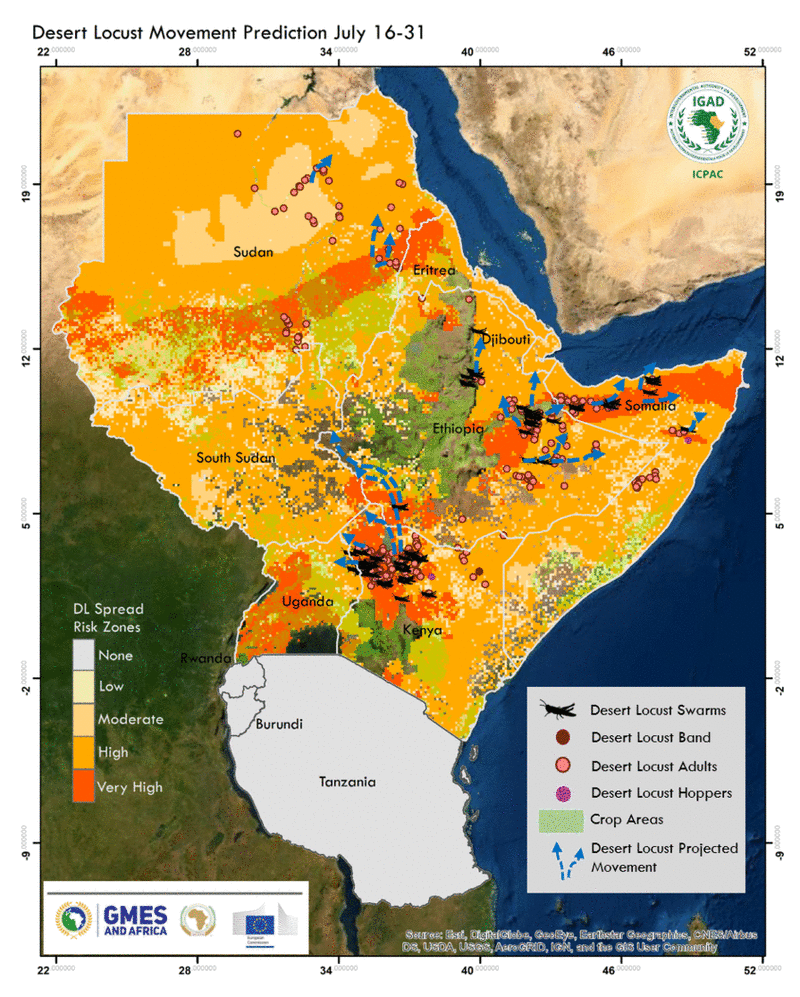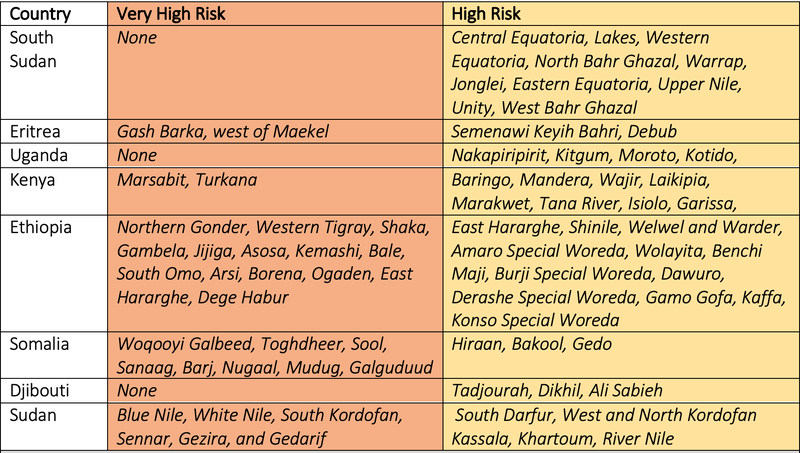Desert Locust Projection 01-15 July
More hopper hatching has been reported in Northern Kenya, Eastern Ethiopia, and Central and Western Somalia.
Projected impact on food and fodder production
- Adult and swarms are still being reported in those areas that hoppers have not been effectively controlled. More hopper hatching has been reported in Northern Kenya, Eastern Ethiopia, and Central and Western Somalia.
- The risk of significant impact to both crops and rangelands is very high due to the increased likelihood of swarms migrating.
- Crops destruction has already been reported in Ethiopia and Somalia. Most affected crops have been sorghum and maize crops at vegetative and ripening stages.
- Agro-pastoral areas of Turkana in Kenya already have reported an impact on crops in areas where the hopper bands have hatched. Most agro-pastoral areas in vegetative stages of crop development are at a high risk of potential damage to seasonal crops and regenerating pastures.
Desert Locust Spread and Prediction
- In the current desert locust invasion areas of the Eastern Africa region, locust swarms have densified yet again in northern Kenya, and eastern and north-eastern Ethiopia.
- Locust band and hoppers are also notably in large numbers in the areas where swarms have been reported and in the trajectories of the paths previously predicted. This means swarms have been migrating and laying eggs in their paths. Northern parts of Sudan have had locusts reported.
Climatic conditions suitable for desert locust development are forecast to be highly suitable in southern and eastern South Sudan, eastern Ethiopia, north-eastern Somalia and northern Kenya.
Ecological conditions (particularly the availability of green vegetation) are most suitable in parts of Kenya, South Sudan, Ethiopia and Somalia, due to a continuation of rainfall received in the season which enhanced vegetation regrowth.
Wind direction and speeds, which greatly determine swarm movement, is forecast to be southerly and south-westerly in Somalia. This lowers risk for an invasion for the southern and equatorial subregion, and increased risk in northern countries of the region.
Invasion status: desert locust hopper bands, adult locust and swarms continue to be reported in Turkana and Marsabit in Kenya, and Ogaden and Dire Dawa in Ethiopia. Hopper bands have also been recorded in multiple areas of Afar, Tigray and Somali regions of Ethiopia. In Somalia, Awdal, Woqooyi Galbeed, Mudug, Nugaal, Sool and Sanaag have hopper groups reported.
Desert locusts are projected to move from:
- Turkana areas of Kenya to eastern South Sudan and western Ethiopia areas of Gambela;
- Ethiopia Somali regions to north-eastern Somalia; and
- North-eastern Ethiopia to areas of Djibouti and towards and acrross the Red Sea.
- Intermittent multi-directional winds might favour swarms to move in opposing directions during the projection period.
Note: Locust locations obtained from FAO Locust Hub: https://locust-hub-hqfao.hub.arcgis.com/. Data downloaded 29 July 2020.

Highest risk areas for desert locust invasion based on forecasted suitable climate and existing vegetation conditions are outlined below:

Note: Risk areas consider a combination of wind movement, ecological conditions and forecasted weather indicators.
